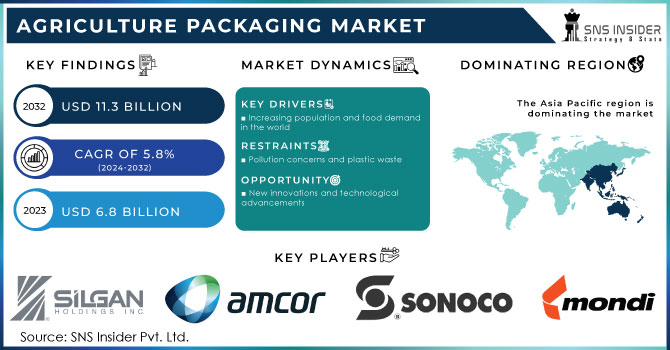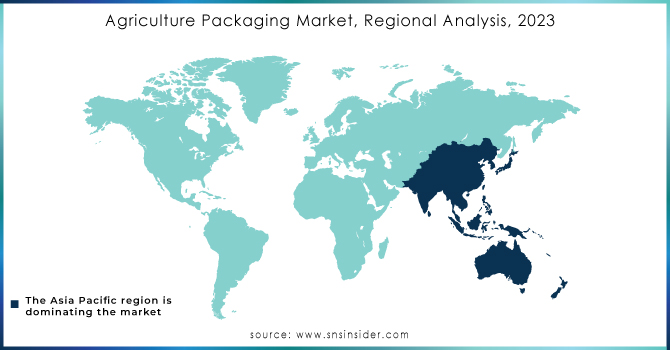Agriculture Packaging Market Report Scope & Overview:

Get More Information on Agriculture Packaging Market - Request Sample Report
The Agriculture Packaging Market size was USD 6.8 billion in 2023 and is expected to Reach USD 11.3 billion by 2032 and grow at a CAGR of 5.8% over the forecast period of 2024-2032.
The International Monetary Fund estimates that by 2050, the world's population will reach 9.7 billion. The demand for food will continue to increase as the world's population grows. This implies the need for effective packaging solutions throughout the entire supply chain to ensure that crops are kept and protected. More and more people are looking for fresh, quality agricultural products. In order to maintain the visual appeal and nutritional value of these products, packaging plays an essential role. The shelf life and quality of agricultural products have been improved by innovation in packaging materials and technologies, e.g. the use of modified atmosphere packaging MAP as well as active packaging.
Over 90 % of food waste in developing countries is generated by storage and transport, according to the Birmingham Energy Institute. Accordingly, the demand for cost effective and sustainably produced agricultural packaging solutions is being driven by increasing awareness of food loss in harvesting and shipping.
Flexible packaging is mainly used for food, representing more than 60% of the total market according to the Flexible Packaging Association. Furthermore, because of consolidation in the international e commerce sector, flexible packaging is expected to become an increasingly common form of packaging during the forecast period.
MARKET DYNAMICS
KEY DRIVERS:
-
Increasing population and food demand in the world
The need to provide effective and sustainability agriculture packaging solutions is driven by an increase in world population and the subsequent growth of food demand. Packaging, which ensures that agricultural products reach consumers in the best possible conditions, has an important role to play in protecting their quality, safety and shelf life. The number of people worldwide has risen more than 3 times since the 20th century, in fact, according to data from the United Nations.
There were 8.0 billion people on earth by mid November 2022, up from 2.5 billion during the 1950s, 1 billion since 2010, and 2 billion since 1998. The population of the world is projected to rise by about 2 billion people over the next 30 years, from the present 8 billion to 9.7 billion in 2050, with a potential peak of roughly 10.4 billion in the middle of the 2080s. By 2050, as well, food demand is projected to increase anywhere between 59% and 98%. Consequently, the market for packaging in agriculture is expected to grow during the forecast period on the back of population growth worldwide and increasing food demand.
RESTRAIN:
-
Pollution concerns and plastic waste
Due to its environmentally harmful effect, the use of plastics packaging in agriculture is subject to increased scrutiny. Concerns about waste plastics and pollution have led to calls for reduced use of plastics as well as an increase in the acceptance of viable packaging alternatives. The development and implementation of more environmentally compatible products will therefore be a challenge for the agricultural packaging sector.
OPPORTUNITY:
-
New innovations and technological advancements
Technological advances and innovations are driving the agricultural packaging industry. With a view to meeting industry's ever increasing needs, new materials, packaging forms and technologies are constantly being developed. Advances in barrier properties, smarter packaging, intelligent labels and active packaging solutions that increase the freshness, traceability and satisfaction of consumers are also part of this.
CHALLENGES:
-
Cost of Packaging Materials
Due to factors such as oil prices and geopolitical tensions, the cost of raw materials can rise considerably, especially plastics based on petroleum. This fluctuation is having a negative impact on the profitability of producers as well as farmers, in terms of total production costs and prices for agricultural packaging.
IMPACT OF RUSSIAN UKRAINE WAR
In 2023, the global market for agricultural packaging is expected to decrease by 2.5% as a result of the war in Ukraine. As a result of the war, packaging material costs such as plastic, paper and metal have increased. This is due to the disruption of supplies as a result of the war and an increase in transport costs. The rise of the London Metal Exchange LME index by almost 10 % last week to 5,409.30 currently represents an indication of a price spike for raw materials. On March 7, it hit a record high of 5,505 before falling back. Overall, there has been a slight increase of over 20 % year to date in the index for aluminium, copper, nickel, lead, zinc and tin. Following the crisis in Russia and Ukraine, aluminium is another metal which has risen to record heights. Even though prices fell to $3,498 per tonne from an all time high of$4,103 on March 7, they're up 24 % so far this year. In total, Russia is responsible for 6% of global aluminium production.
IMPACT OF ONGOING RECESSION
The global recession is expected to have a negative impact on demand for agricultural products, as consumers cut their consumption of noncrucial goods. This may lead to a reduction in demand for agricultural packaging.
KEY MARKET SEGMENTS
By Material
-
Plastic
-
Metal
-
Paper & Paperboard
-
Composite materials
-
Others
By Product Type
-
Drums
-
Pouches & Bags
-
Bottles & Cans
-
Others
Pouches and Bags segment by Product type accounted for the largest market share of around 43 %. Due to its safety it will continue its dominance over the forecast period.
By Barrier Strength
-
Low
-
Medium
-
High
By Application
-
Chemical Pesticides
-
Biologicals
-
Chemical Fertilizers
REGIONAL ANALYSIS
Given the growing agriculture sector, Asia Pacific is expected to be the major market during the forecast period. The region is home to some of the world's biggest farm producers, such as China and India. It has a wide variety of agricultural products, such as grains, fruits, vegetables, meat and milk. Demand for efficient packaging solutions in order to guarantee the quality and safety of agricultural products is driven by increasing populations and rising middle class consumers in countries such as China and India.
According to the WorldData, India's population rose from 450.55 million in 1960 to 1.43 billion by 2023. In 63 years, that's an increase of 216.5%. At 2.36% and the lowest growth will occur in 2023 at a rate of 0.61%, 1974 proved to be India's most successful year.
Due to the advanced infrastructure and stringent quality standards, North America is expected to account for a significant market share over the forecast period. A strong infrastructure, including efficient transport networks, modern storage facilities and advanced packaging technologies, is in place in the region to support the agricultural sector. North America is expected to hold the 22.8 % market share in terms of revenue in the year 2022. US is expected to hold the 20.5 % market share in terms of revenue.

Get Customized Report as per Your Business Requirement - Request For Customized Report
REGIONAL COVERAGE:
North America
-
US
-
Canada
-
Mexico
Europe
-
Eastern Europe
-
Poland
-
Romania
-
Hungary
-
Turkey
-
Rest of Eastern Europe
-
-
Western Europe
-
Germany
-
France
-
UK
-
Italy
-
Spain
-
Netherlands
-
Switzerland
-
Austria
-
Rest of Western Europe
-
Asia Pacific
-
China
-
India
-
Japan
-
South Korea
-
Vietnam
-
Singapore
-
Australia
-
Rest of Asia Pacific
Middle East & Africa
-
Middle East
-
UAE
-
Egypt
-
Saudi Arabia
-
Qatar
-
Rest of Middle East
-
-
Africa
-
Nigeria
-
South Africa
-
Rest of Africa
-
Latin America
-
Brazil
-
Argentina
-
Colombia
-
Rest of Latin America
Key Players
Some major key players in the Agriculture Packaging market are Mondi, Amcor plc, Silgan Holdings Inc, Bemis Manufacturing Company, Greif, ProAmpac, Packaging Corporation of America, Pactiv Evergreen Inc., LC Packaging, Sonoco Products Company and other players.
RECENT DEVELOPMENT
- Mondi made an acquisition of Olmuksan, the largest producer of Corrugated Packaging in Turkey, in January 2021. The company will seek to increase its market presence in the packaging sector and reinforce its position through this acquisition.
| Report Attributes | Details |
| Market Size in 2023 | US$ 6.8 Bn |
| Market Size by 2032 | US$ 11.3 Bn |
| CAGR | CAGR of 5.8 % From 2024 to 2032 |
| Base Year | 2023 |
| Forecast Period | 2024-2032 |
| Historical Data | 2020-2022 |
| Report Scope & Coverage | Market Size, Segments Analysis, Competitive Landscape, Regional Analysis, DROC & SWOT Analysis, Forecast Outlook |
| Key Segments | • by Material (Plastic, Metal, Paper & Paperboard, Composite materials, Others) • by Product Type (Drums, Pouches & Bags, Bottles & Cans, Others) • by Barrier Strength (Low, Medium, High) • by Application (Chemical Pesticides, Biologicals, Chemical Fertilizers), |
| Regional Analysis/Coverage | North America (US, Canada, Mexico), Europe (Eastern Europe [Poland, Romania, Hungary, Turkey, Rest of Eastern Europe] Western Europe] Germany, France, UK, Italy, Spain, Netherlands, Switzerland, Austria, Rest of Western Europe]), Asia Pacific (China, India, Japan, South Korea, Vietnam, Singapore, Australia, Rest of Asia Pacific), Middle East & Africa (Middle East [UAE, Egypt, Saudi Arabia, Qatar, Rest of Middle East], Africa [Nigeria, South Africa, Rest of Africa], Latin America (Brazil, Argentina, Colombia Rest of Latin America) |
| Company Profiles | Mondi, Amcor plc, Silgan Holdings Inc, Bemis Manufacturing Company, Greif, ProAmpac, Packaging Corporation of America, Pactiv Evergreen Inc., LC Packaging, Sonoco Products Company |
| Key Drivers | • Increasing population and food demand in the world |
| Key Restraints | • Pollution concerns and plastic waste |

